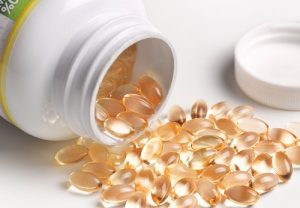
Our ancestors evolved under the rays of the equatorial sun. Skin produces Vitamin D (VitD) when exposed to specific frequencies of ultraviolet light. Our bodies advantageously incorporated this readily available, natural resource into many aspects of growth, development and function. As man migrated away from the sun, skin mutated thereby reducing melanin content in an attempt to maximize essential VitD production. Over the past half-century, effective technologies to eliminate all cutaneously-generated VitD synthesis have been developed as part of a systematic vilification of the sun in regard to its contribution to general health. Consequently, the incidence of the diseases that plague the developed world (cancers, cardiovascular diseases, autoimmune diseases) are at the highest levels ever, with no ceiling in sight.
 Presently, the Institute of Medicine recommends 600 IU of Vitamin D3 daily for most adults. This amount of VitD is enough to keep bones from crumbling and the development of rickets, a bone-deforming disease, but not much else. Consider this: when young 20-year-old skin is exposed to full spectrum sunlight, the equivalent of 25,000 IU VitD is made in 15 minutes. A healthy adult will use approximately 3,500 IU of VitD per day. In the absence of UVB light, the recommended 600 IU per day quickly leads to VitD starvation. Consequently, most people are VitD deficient, some severely so.
Presently, the Institute of Medicine recommends 600 IU of Vitamin D3 daily for most adults. This amount of VitD is enough to keep bones from crumbling and the development of rickets, a bone-deforming disease, but not much else. Consider this: when young 20-year-old skin is exposed to full spectrum sunlight, the equivalent of 25,000 IU VitD is made in 15 minutes. A healthy adult will use approximately 3,500 IU of VitD per day. In the absence of UVB light, the recommended 600 IU per day quickly leads to VitD starvation. Consequently, most people are VitD deficient, some severely so.
It is estimated that 75 percent of the population of the United States has blood levels of VitD below 20 ng/ml; indicative of a state of VitD starvation. Since most foods provide insignificant amounts of VitD, the state of chronic starvation is compounded by sunscreen use, air pollution, skin color, indoor lifestyle, obesity, age and living at a northern (greater) latitude. For example, due to the angle of the sun in the northern hemisphere during October to May, the VitD-generating UVB rays deflect off the atmosphere, resulting in no cutaneous generation of VitD. So even though the sun may feel nice on the face in the winter, it’s not generating any VitD.
Vitamin D is really not a vitamin at all, but is one of the most potent hormones in the body. The VitD made by the skin or taken by mouth circulates in the blood and is converted to the active hormonal form by the kidney or at the target tissue receptor. Just about every cell in the body has a receptor for VitD — again suggesting how critical VitD is in cellular function. The active form of VitD, 1,25(OH)D3, is the interesting substance involved in the beneficial health effects of VitD. 1,25(OH)D3 attaches to its receptors throughout the body and affects the transcription of genes. The expression of information in genes is basically the recipe of life; how new tissue should be synthesized or made, and how systems and organs should function. Common sense suggests that removing an essential biological substance like 1,25(OH)D3 will result in adverse consequences.
In the United States, many disorders have distinct North-South gradients, with the incidence of various autoimmune diseases (multiple sclerosis, psoriasis, arthritis, Crohn’s Disease, ulcerative colitis), certain cancers (breast, prostate, colon, lung) and some cardiovascular diseases more prevalent at greater latitudes. In the Southern hemisphere, the gradient is reversed South-North, yet remains consistent with regard to latitude. Greater latitudes result in less sunlight exposure, consequently less VitD production and generally lower measured serum VitD levels in people living in higher latitudes. A recent study involving thousands of subjects summed up the risk of not getting enough VitD succinctly in its title: Strong associations between 25-hydroxyvitamin D concentrations with all-cause, cardiovascular, cancer and respiratory disease mortality (Schottker, et. al, 2013).
Take-home message: the lower the level of VitD, the greater the chance of death.
Vitamin D, Inflammation and Disease
Chronic inflammation kills…it’s just a matter of how and when.
Vitamin D is necessary for the proper function of the immune system. Without adequate Vitamin D, the immune system disrupts healthy tissue function by mistakenly attacking it, causing inflammation – generally referred to as autoimmune disease. Autoimmune disease affects widely different systems in the body, but shares a common feature: immune system dysfunction producing chronic inflammation. Atheriosclerosis, psoriasis, arthritis, multiple sclerosis, cancers of epithelial origin (colon, breast, prostate, lung), Crohn’s disease and ulcerative colitis are examples of autoimmune diseases affecting disparate tissue types from blood vessels to skin to brain cells. However, these conditions all share a common cause: inflammation resulting, in many instances, from vitamin D deficiency. Correct the vitamin D deficiency and remove the inflammation that may be at the root of the autoimmune disease.
Not surprisingly, many of the side-effect ridden prescription drugs that offer temporary help with some of these conditions affect the immune system in much the same manner as does VitD. As an example, by modulating the function of tumor necrosis factor, Infliximab (trade name Remicade) reduces inflammation but not without great cost. Without adequate VitD, the immune system does not function properly. The immune system ‘misreads’ signals and attacks healthy tissue causing inflammation. Inflammation causes the symptoms of autoimmune disease. Chronic inflammation is often a precursor to the development of a variety of serious conditions mentioned above. Correct the VitD deficiency to normalize immune system function, and, hopefully, avoid serious problems.
What To Do
If most of this information is new to you, you’re not alone. Many will appreciate that there must be consequences of removing an essential biological substance like VitD. Those consequences are expressed as the rampant growth of autoimmune diseases and cancer.
Start getting some sensible sun exposure during the summer months. Sunburns are associated with elevated risk of melanoma, sensible sun exposure is not.
Most must supplement in the winter months to avoid VitD starvation. Take vitamin D3; this is the type of vitamin D that our bodies incorporate best. Vitamin D2, which is an expensive prescription form of VitD, is of questionable value as studies have shown it to be 87 percent less bioactive than a comparable dose of D3. Furthermore, buy VitD3 in small quantities, a month’s supply at most, as VitD potency rapidly degrades when exposed to air. Buying the garbage can size at Costco is pointless since the expiration countdown starts once the can is opened.
How Much Vitamin D do you Need?
Conventional thinking among various VitD scientists and physicians is that between 2,000 and 5,000 IU per day is appropriate for most healthy adults. While these amounts may seem like a lot, keep in mind that the body can produce 10,000 to 25,000 IUs of vitamin D after 10-15 minutes of full body summer sun exposure. Vitamin D toxicity is very rare. It can happen to those who take 40,000 IU a day for a couple of months or longer. And in such isolated instances, the treatment is to simply stop taking the additional VitD until blood levels drop. It is impossible to ‘overdose’ from sun-generated VitD as there are checks and balances in place to prevent overproduction. Have you ever seen an unhealthy looking lifeguard?
Get your VitD level tested. A simple blood test can tell you what you need to know. Depending on the extent of the deficiency, the amount of VitD and the time necessary to get into a specific range will vary. The following table is a rough guideline for assessing VitD status:
| Vitamin D Status | Serum Level |
| Deficient | 0 – 30 ng/ml |
| Insufficient | 31 – 39 ng/ml |
| Sufficient | 40 – 60 ng/ml |
| Ideal | 61 – 90 ng/ml |
As a very general rule of thumb, all other things being equal, a tablet containing 5,000 IU of VitD3 will get serum levels around 50 ng/ml after one to two months of daily use.
In some diseases, researchers have studied the benefits of high doses of vitamin D. If you have a disease for which research has shown there may be a benefit in taking larger amounts of vitamin D, and if you would like to consider taking more than 10,000 IU/day, work with your doctor.
Test your vitamin D [25(OH)D] levels every 3 months and make sure that your blood levels are within a safe and healthy range.
If you have an inflammation-based condition that you think might benefit from VitD, do some research—maybe there is a VitD connection. Be an advocate for your own well-being and those around you. Involve your healthcare provider.
If you are in good health with no known inflammation-based disorders, keep it that way. As the saying goes, an ounce of prevention is worth a pound of cure. The common sense of VitD coupled with the growing body of peer-reviewed, scientifically-valid studies examining the role of VitD in general health is compelling. Inflammation, muscle strength and growth, and the genetic basis of aging itself are all intimately related to VitD. The amazing story that is VitD is just beginning to be told, make sure you’re around to benefit from it.
QUIZ: Are you smarter than a lizard? Cold-blooded animals sun themselves to get warm right? Wrong. Lizards injected with VitD prior to being placed in the sun don’t sun themselves as long as lizards injected with a placebo. Furthermore, the effect is dose-dependent; the more VitD that’s injected into the lizard, the less time it spends in the sun. The lizard is measuring blood levels of VitD and regulating its sun exposure based on that measure. The lizard is ‘smart’ enough to go into the sun to get its VitD. Do you go in the sun?
On a personal note, I was plagued by plaque psoriasis for 20 years. I eradicated it with a combination of vitamin D3 and folic acid seven years ago. My serum levels are between 80-110 ng/ml. My wife suffered from ulcerative colitis which was eliminated as well once we realized the inflammation-based link between both disparate conditions. Both diseases did not respond to traditional treatments, yet were wiped out by simple vitamin D. Absolutely amazing!
William F. Supple, Jr., Ph. D. received his doctorate in Neuroscience from Dartmouth. He is one of the founders of StarPower LifeSciences, a not-for-profit educational foundation whose mission is to spread enlightenment regarding the power of Vitamin D in health, disease and longevity.
 Related Articles & Free Vermont Maturity Subscription
Related Articles & Free Vermont Maturity Subscription
Do You Need to Take a Dietary Supplement?






Comment here